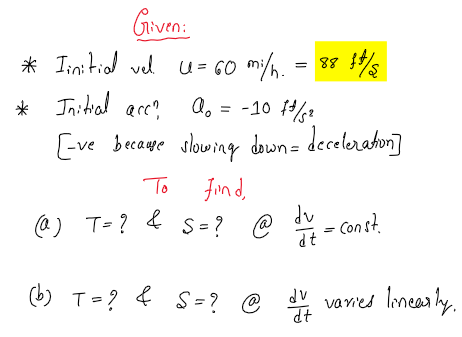A motorist traveling on a highway at a speed of 60 mi/h exits onto an ice-covered exit ramp. Wishing to stop, he applies his brakes until his automobile comes to rest. Knowing that the magnitude of the total acceleration of the automobile cannot exceed 10 ft/s?, use computational software (MATLAB, Excel, or any) to determine the minimum time required for the automobile to come to rest and the distance it travels on the exit ramp during that time if the exit ramp (1) is straight. Also, solve (1) assuming that the driver applies his brakes so that dv/dt, during each time
A motorist traveling on a highway at a speed of 60 mi/h exits onto an ice-covered exit ramp. Wishing to stop, he applies his brakes until his automobile comes to rest. Knowing that the magnitude of the total acceleration of the automobile cannot exceed 10 ft/s?, use computational software (MATLAB, Excel, or any) to determine the minimum time required for the automobile to come to rest and the distance it travels on the exit ramp during that time if the exit ramp (1) is straight. Also, solve (1) assuming that the driver applies his brakes so that dv/dt, during each time
Elements Of Electromagnetics
7th Edition
ISBN:9780190698614
Author:Sadiku, Matthew N. O.
Publisher:Sadiku, Matthew N. O.
ChapterMA: Math Assessment
Section: Chapter Questions
Problem 1.1MA
Related questions
Question

Transcribed Image Text:A motorist traveling on a highway at a speed of 60 mi/h exits onto an ice-covered exit ramp.
Wishing to stop, he applies his brakes until his automobile comes to rest. Knowing that the
magnitude of the total acceleration of the automobile cannot exceed 10 ft/s?, use computational
software (MATLAB, Excel, or any) to determine the minimum time required for the automobile
to come to rest and the distance it travels on the exit ramp during that time if the exit ramp (1) is
straight. Also, solve (1) assuming that the driver applies his brakes so that dv/dt, during each time
interval, (a) remains constant, and (b) varies linearly.
Expert Solution
Step 1

Trending now
This is a popular solution!
Step by step
Solved in 4 steps with 7 images

Knowledge Booster
Learn more about
Need a deep-dive on the concept behind this application? Look no further. Learn more about this topic, mechanical-engineering and related others by exploring similar questions and additional content below.Recommended textbooks for you

Elements Of Electromagnetics
Mechanical Engineering
ISBN:
9780190698614
Author:
Sadiku, Matthew N. O.
Publisher:
Oxford University Press

Mechanics of Materials (10th Edition)
Mechanical Engineering
ISBN:
9780134319650
Author:
Russell C. Hibbeler
Publisher:
PEARSON

Thermodynamics: An Engineering Approach
Mechanical Engineering
ISBN:
9781259822674
Author:
Yunus A. Cengel Dr., Michael A. Boles
Publisher:
McGraw-Hill Education

Elements Of Electromagnetics
Mechanical Engineering
ISBN:
9780190698614
Author:
Sadiku, Matthew N. O.
Publisher:
Oxford University Press

Mechanics of Materials (10th Edition)
Mechanical Engineering
ISBN:
9780134319650
Author:
Russell C. Hibbeler
Publisher:
PEARSON

Thermodynamics: An Engineering Approach
Mechanical Engineering
ISBN:
9781259822674
Author:
Yunus A. Cengel Dr., Michael A. Boles
Publisher:
McGraw-Hill Education

Control Systems Engineering
Mechanical Engineering
ISBN:
9781118170519
Author:
Norman S. Nise
Publisher:
WILEY

Mechanics of Materials (MindTap Course List)
Mechanical Engineering
ISBN:
9781337093347
Author:
Barry J. Goodno, James M. Gere
Publisher:
Cengage Learning

Engineering Mechanics: Statics
Mechanical Engineering
ISBN:
9781118807330
Author:
James L. Meriam, L. G. Kraige, J. N. Bolton
Publisher:
WILEY